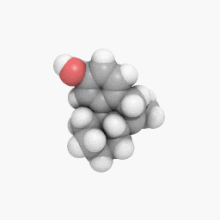 | |
 | |
| Clinical data | |
|---|---|
| Other names | DXO, Dextrorphanol |
| ATC code |
|
| Legal status | |
| Legal status |
|
| Identifiers | |
| |
| CAS Number | |
| PubChem CID | |
| ChemSpider | |
| UNII | |
| ChEMBL | |
| CompTox Dashboard (EPA) | |
| ECHA InfoCard | 100.004.323 |
| Chemical and physical data | |
| Formula | C17H23NO |
| Molar mass | 257.377 g·mol−1 |
| 3D model (JSmol) | |
| |
| |
| | |
Dextrorphan (DXO) is a psychoactive drug of the morphinan class which acts as an antitussive or cough suppressant and in high doses a dissociative hallucinogen. It is the dextrorotatory enantiomer of racemorphan; the levorotatory enantiomer is levorphanol. Dextrorphan is produced by O-demethylation of dextromethorphan by CYP2D6. Dextrorphan is an NMDA antagonist and contributes to the psychoactive effects of dextromethorphan.[2]
- ^ Bensinger, Peter (October 1, 1976). "Dextrophan and Nalbuphine; Removal from Schedules" (PDF). NARA. Retrieved June 26, 2023.
- ^ Zawertailo LA, Kaplan HL, Busto UE, Tyndale RF, Sellers EM (August 1998). "Psychotropic effects of dextromethorphan are altered by the CYP2D6 polymorphism: a pilot study". Journal of Clinical Psychopharmacology. 18 (4): 332–337. doi:10.1097/00004714-199808000-00014. PMID 9690700.